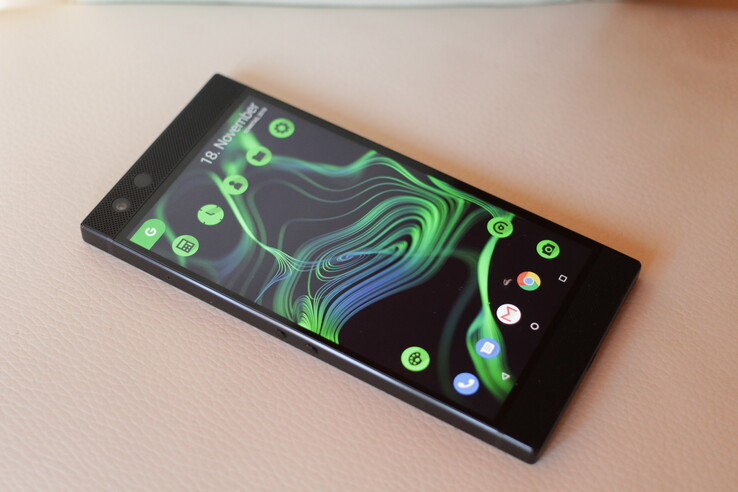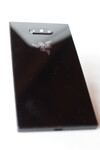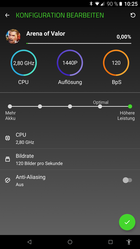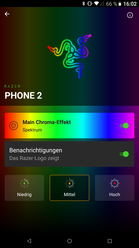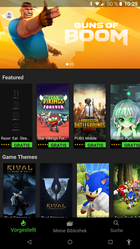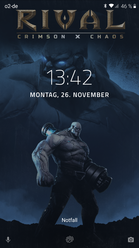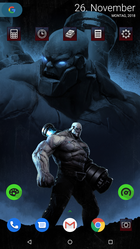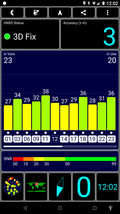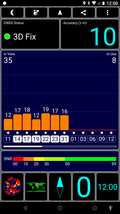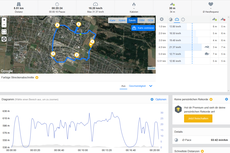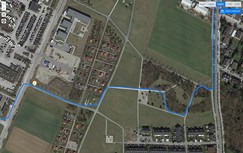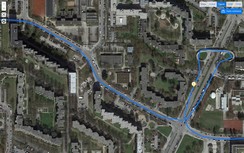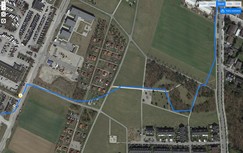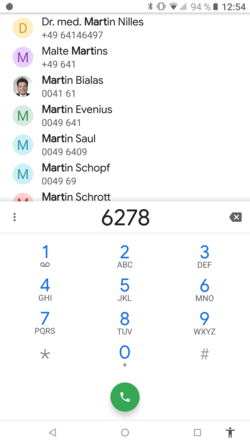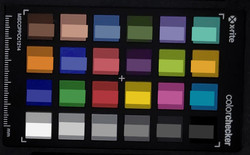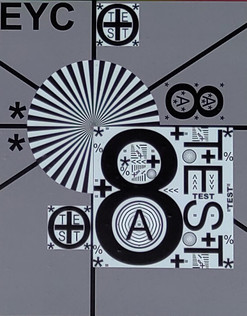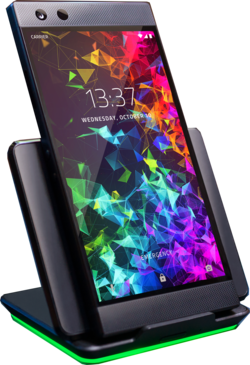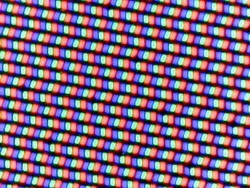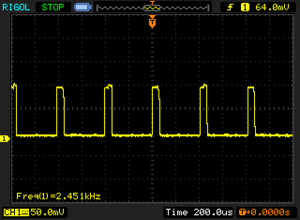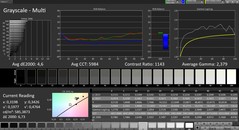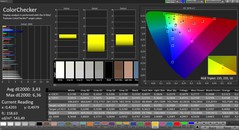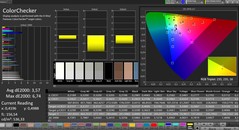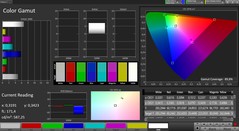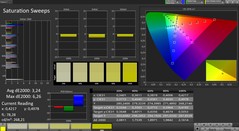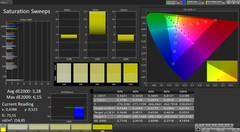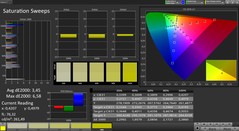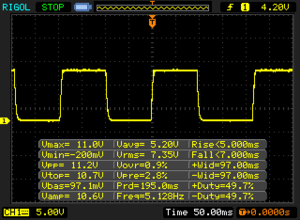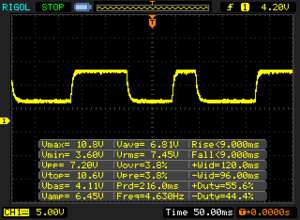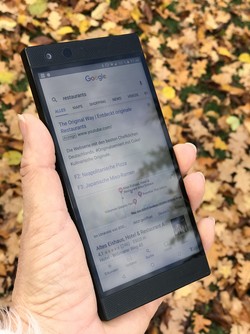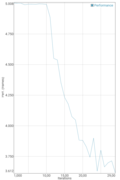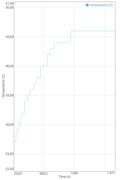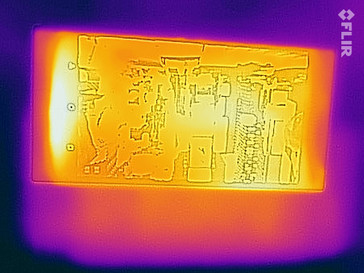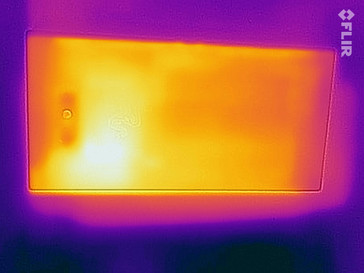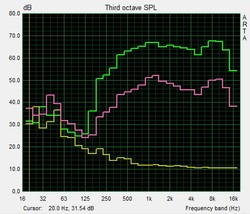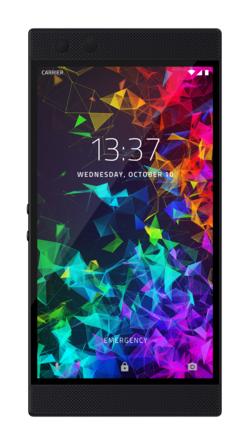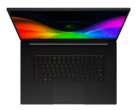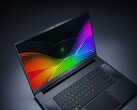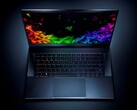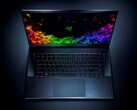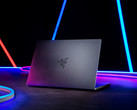Razer Phone 2 Smartphone Review
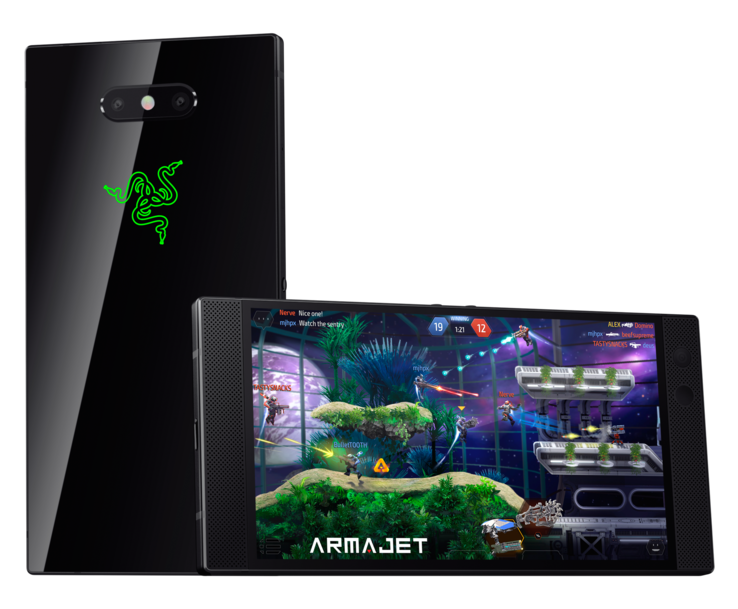
The pure looks of Razer’s latest smartphone gave us the heebie-jeebies already, and the high-quality gaming equipment manufacturer has pimped its smartphone with the Razer Chroma Technology genes. According to Razer, Chroma is the largest and most widespread RGB lighting system for gamers. In addition to some cosmetic software updates, the new phone also features the latest and greatest in smartphone technology: Qualcomm’s Snapdragon 845 with a vapor-chamber cooler for longer lasting high performance under sustained load.
A technology that can be also found in some competitors, namely the Asus ROG Phone and Xiaomi Black Shark gaming smartphones. Other rivals include the Sony Xperia XZ3 with its very tactile feedback engine and the iPhone Xs Max as a powerful, non-Android, gaming smartphone alternative.
Case
Admittedly, we rarely consider the manufacturer logo on a smartphone to be a highlight. More likely than not it is going to be annoying if it grows too large. Not so with the Razer Phone 2. Not only is the large three-headed snake nice to look at, it also lights up in every single color in the RGB spectrum. In other words: up to 16.7 million colors or, alternatively, a preselected favorite color.
At the front we find wide speakers atop and below the display, which make for rather thick and not particularly contemporary display bezels. The case itself is incredibly sturdy and reminds us of Sony’s angular square-edged Xperia smartphones, just bulkier and more robust. At 219 g (~7.7 oz), the 8.5 x 159 x 79 mm (0.33 x 6.26 x 3.11 inches) large device turned out to be the heaviest smartphone of our test group, including the Phone 2017. This impression of bulkiness is further reinforced by the wide speaker grills, and haptics were not particularly impressive.
Nevertheless, the Razer Phone 2 is a very classy phone. The color on its backside is dubbed “Mirror Black” by Razer, and it is completely covered by glass thereby accentuating the either static or pulsating Razer Logo. The camera lens protrudes by around 1 mm from the case but the phone can be easily used face-up on a table.
In its own web store, Razer Mobile also has a model in “Satin Black” on offer. Both SKUs are IP67-certified for protection against dust and submersion in up to 1 m (around 3 ft) of fresh water.
Connectivity
The device is equipped with the fastest mobile hardware currently available: Qualcomm’s Snapdragon 845 and 8 GB of LPDDR4X RAM. At just 64 GB storage space is a bit on the low side for a flagship smartphone, though. Many other smartphones are equipped similarly but we would have expected a gaming smartphone made for games with gigabytes of extra content to be more generously equipped. At least storage space can be expanded by use of a microSD card that can be formatted as internal storage and used for storing apps and games. By installing said microSD card you lose the secondary SIM slot and therefore the device’s dual SIM capabilities.
Like its predecessor, the Phone 2 lacks a 3.5-mm headphone jack and offers no more than a single USB-C port for audio equipment. A first for Razer is the volume rocker that is no longer a rocker but two separate buttons instead. As they are located on the left side in the middle, they are a bit too low for the index finger and are closer to your middle finger instead.
Software
On top of Android 8.1 with security patches as of October 5, 2018, we find the Nova Launcher that is also available in Google’s Play Store and can be retroactively installed on other smartphones as well. The popular launcher is highly adjustable and allows individualization of the home screen, the overall look and feel, and several gestures. Razer created several icon themes in collaboration with various game studios, which are available in Razer’s own theme store. Among others, you can find icon themes for Fortnite, PUBG, and Tekken.
The games themselves are installed via either Razer’s Cortex app or Google’s Play Store. The Cortex App specifically lists games with support for 120 Hz displays. The Game Booster, a standalone application on the last model, has now been integrated into the Cortex app.
The RGB logo is not configured via a dedicated app but the phone’s settings menu. In addition to color and effect (static, spectrum, breathing) settings also include a battery-aware intensity and an option to turn the logo into a notification LED. The Razer logo is the only notification LED on this phone.
We were unable to uninstall any of the preloaded apps. While we did not mind the Razer software, the Dolby Atmos app, or even the YouTube app we were skeptical about Netflix despite the fact that the Razer Phone 2 is capable of HDR and Dolby Digital Plus 5.1 playback. If you do not use Netflix you should be able to remove the app completely.
Communication and GPS
Not every single aspect of the Razer Phone 2 is superior to its predecessor. When connected to our Linksys EA8500 reference router, the transfer speeds of the Razer Phone were actually higher than the Razer Phone 2’s by a significant margin. Overall, the Razer Phone 2 still did very well in this test, and the connection remained rock solid even at a higher distance.
The only relevant LTE band missing is band 19 that is used by the Japanese provider NTT DoCoMo. Other than that, all important and widely used LTE bands are supported.
| Networking | |
| iperf3 transmit AX12 | |
| Razer Phone 2017 | |
| Apple iPhone Xs Max | |
| Razer Phone 2 | |
| Xiaomi Black Shark | |
| Asus ROG Phone | |
| iperf3 receive AX12 | |
| Razer Phone 2017 | |
| Apple iPhone Xs Max | |
| Razer Phone 2 | |
| Xiaomi Black Shark | |
| Asus ROG Phone | |
GPS accuracy was pretty decent. Outdoors, the GPS test application attested an accuracy of 3m (~10 feet). Indoor accuracy was determined to be around 10 m (~33 feet). Both results are respectable.
We test every smartphone on a short biking trip around the block comparing it to a professional Garmin Edge 520 satnav. As can be seen on the photos below the Razer Phone 2 was not particularly accurate when on the move and placed us at quite a distance from our actual track in the woods and at an intersection.
The results seem to indicate that the phone did not skip any checkpoints but rather that its accuracy was low at these spots. Overall, the track recorded by the Razer Phone 2 was 260 m (850 ft) shorter than the one recorded by the Garmin Edge 520. You should keep that in mind if navigation track recording is of importance to you.
Telephony and Call Quality
Razer opted for the default Google telephone app. The Phone 2’s speakers are powerful enough for a very enjoyable hands-free experience. Voices sometimes seemed a bit distorted, and unfortunately, they were muffled when using a headset. This improved dramatically when using the included 3.5-mm USB-C DAC: a 3.5-mm headset connected to the Razer Phone 2 via this adapter carried voices much clearer and louder.
Cameras
Thanks to optical image stabilization (OIS) and a wide open f/1.75 aperture the rear-facing dual 12 MP camera was capable of taking decent photos even in poor lighting conditions. Two dual-tone LEDs ensure natural lighting conditions and serve as flashlights.
Videos were also very brightly lit even when filmed indoors under somewhat fading light. Unfortunately, focus suffered under these conditions. The front-facing camera records videos in HD, the rear-facing camera is capable of 4K recording.
Both sensors are made by Sony. The secondary lens is a tele-lens with an aperture of f/2.6. Both lenses are used for portrait mode.
When using the front-facing 8 MP f/2.0 camera the portrait mode effect is rendered by software only. The results were pretty impressive and comparable to other top-range smartphones. Color representation was generally very natural.
Compared to other top-range smartphone cameras the Phone 2 stood out thanks to its very accurate focus. Details were very clear and well pronounced even when zoomed-in.
We test every camera under normalized conditions as well. Looking at the ColorChecker Passport depicting the reference color in the top half of each square we can clearly see that the Razer Phone 2 captured colors and grayscale a bit too dark.
The test chart, in return, was crisp and in focus not just in the center but also around the sides in the top half of the photo. Unfortunately, the bottom half was a bit blurry towards both sides.
Accessories and Warranty
Like its predecessor, the Razer Phone 2 does not have a 3.5-mm headphone jack, and Razer also decided not to include a USB-C headset. Instead, we found a high-quality 3.5-mm USB-C DAC that can be used to connect any 3.5-mm headset to the Razer Phone 2. The difference between a normal adapter and this high-quality model was very noticeable. In addition to the DAC, the box also includes a power supply and a USB cable with USB-C connectors on both ends. The cable can thus be used to connect the Phone 2 to a MacBook. Older computers with USB-A ports will require an extra adapter.
For $99 you can purchase the Razer Phone 2 Wireless Charger, a wireless charging dock with integrated Chroma RGB lighting in its base.
The phone itself and all of its accessories come with a 12-month warranty by default. Please see our Guarantees, Return policies and Warranties FAQ for country-specific information.
Input Devices and Handling
The only preloaded keyboard app on the Phone 2 is Google’s Gboard, a well-known and highly customizable keyboard application. In addition to settings for form and function, such as color, background, position and size, the keyboard also includes an optional extra numerical row above the standard rows of keys and a setting to determine whether or not the secondary key assignment is displayed next to the primary assignment.
The 120 Hz display was very smooth and responsive, and it is accompanied by a 120 Hz sampling rate.
The fingerprint reader required some getting used to, at least if you are already used to sensors that react to fingers placed on them. On the Razer Phone 2, the side-mounted fingerprint reader has to be pressed first, which then triggers the scanner. Once pressed the reader was as fast as expected.
Display
The 5.72-inch 19.5:9 display runs at a native resolution of 2,560 x 1,440. Considering its size the resolution is not particularly high, and the reason is its high refresh rate of 120 Hz. After all the SoC needs to render each pixel twice as often as on a regular 60 Hz display. The resolution can be further lowered to FHD and the refresh rate can be lowered to 90 Hz and even 60 Hz in order to go easy on the battery.
The display itself remains an HDR10-compatible IGZO LCD. Unlike OLED displays it requires a backlight, and its black level of 0.31 nits was slightly higher than on its predecessor. Because Razer managed to increase the maximum display brightness from 436 to 600 nits the contrast ratio remained comparable. Brightness distribution was determined to be a good 92%.
| |||||||||||||||||||||||||
Brightness Distribution: 92 %
Center on Battery: 600 cd/m²
Contrast: 1935:1 (Black: 0.31 cd/m²)
ΔE ColorChecker Calman: 3.43 | ∀{0.5-29.43 Ø4.78}
ΔE Greyscale Calman: 4.4 | ∀{0.09-98 Ø5}
97.7% sRGB (Calman 2D)
Gamma: 2.388
CCT: 6069 K
| Razer Phone 2 IGZO LCD, UltraMotion 120 Hz Display, 2560x1440, 5.7" | Razer Phone 2017 IGZO LCD, 120 Hz, Wide Color Gamut, 1440x2560, 5.7" | Asus ROG Phone AMOLED, 2160x1080, 6" | Apple iPhone Xs Max OLED, 2688x1242, 6.5" | Xiaomi Black Shark IPS, 2160x1080, 6" | |
|---|---|---|---|---|---|
| Screen | -5% | -31% | 31% | -34% | |
| Brightness middle (cd/m²) | 600 | 436 -27% | 597 0% | 656 9% | 549 -8% |
| Brightness (cd/m²) | 577 | 417 -28% | 637 10% | 659 14% | 541 -6% |
| Brightness Distribution (%) | 92 | 92 0% | 83 -10% | 88 -4% | 95 3% |
| Black Level * (cd/m²) | 0.31 | 0.16 48% | 0.42 -35% | ||
| Contrast (:1) | 1935 | 2725 41% | 1307 -32% | ||
| Colorchecker dE 2000 * | 3.43 | 3.88 -13% | 5.12 -49% | 1.7 50% | 6.08 -77% |
| Colorchecker dE 2000 max. * | 6.36 | 7.96 -25% | 10.9 -71% | 2.8 56% | 10.69 -68% |
| Greyscale dE 2000 * | 4.4 | 5.8 -32% | 7.3 -66% | 1.7 61% | 6.6 -50% |
| Gamma | 2.388 92% | 2.45 90% | 2.203 100% | 1.998 110% | 2.305 95% |
| CCT | 6069 107% | 7657 85% | 7371 88% | 6487 100% | 8399 77% |
* ... smaller is better
Screen Flickering / PWM (Pulse-Width Modulation)
| Screen flickering / PWM detected | 2451 Hz | ≤ 20 % brightness setting | |
The display backlight flickers at 2451 Hz (worst case, e.g., utilizing PWM) Flickering detected at a brightness setting of 20 % and below. There should be no flickering or PWM above this brightness setting. The frequency of 2451 Hz is quite high, so most users sensitive to PWM should not notice any flickering. In comparison: 53 % of all tested devices do not use PWM to dim the display. If PWM was detected, an average of 8108 (minimum: 5 - maximum: 343500) Hz was measured. | |||
Colors can be adjusted in the display menu, and the phone comes with three different presets. Unfortunately, according to CalMAN, all three profiles suffered from noticeable color distortions. The two profiles “Normal” and “Intense” resulted in a slight blue tint. The profile “Lively” increased color intensity noticeably and evenly.
Display Response Times
| ↔ Response Time Black to White | ||
|---|---|---|
| 12 ms ... rise ↗ and fall ↘ combined | ↗ 5 ms rise | |
| ↘ 7 ms fall | ||
| The screen shows good response rates in our tests, but may be too slow for competitive gamers. In comparison, all tested devices range from 0.1 (minimum) to 240 (maximum) ms. » 30 % of all devices are better. This means that the measured response time is better than the average of all tested devices (20.2 ms). | ||
| ↔ Response Time 50% Grey to 80% Grey | ||
| 18 ms ... rise ↗ and fall ↘ combined | ↗ 9 ms rise | |
| ↘ 9 ms fall | ||
| The screen shows good response rates in our tests, but may be too slow for competitive gamers. In comparison, all tested devices range from 0.165 (minimum) to 636 (maximum) ms. » 31 % of all devices are better. This means that the measured response time is better than the average of all tested devices (31.6 ms). | ||
The IGZO LCD display was very reflective, particularly under a bright sky. Fortunately, the display’s high viewing angles allowed us to look at the display from the side, and the auto-brightness feature was very fast to increase the brightness to a maximum if necessary. This adaptive auto-brightness can be disabled in the display menu of the settings. The quick settings only include a slider to increase or decrease brightness but no option to disable auto-brightness.
Performance
Samsung and Huawei are the two manufacturers that use their own SoCs. All other manufacturers opt for Qualcomm's Snapdragon 845 (MSM845) with the Adreno 630 GPU in case performance is of utmost importance. This SoC was not yet available last year when the Razer Phone was released, but the same chipset is featured in the Xiaomi Black Shark, the Sony Xperia XZ2, and the Asus ROG Phone. Accordingly, those four competitors are head to head in most benchmarks, with the Asus ROG Phone leading by a slight margin most of the time. Asus claims to have a very rigid pre-screening process when selecting the chips for their gaming smartphones, and it shows. Apple’s Bionic CPU plays in a different league, and is significantly faster than all of its competitors. It was only outperformed in the OpenGL benchmarks. However, ever since the introduction of Metal in iOS, OpenGL has become more or less insignificant in the Apple universe.
| PCMark for Android | |
| Work performance score (sort by value) | |
| Razer Phone 2 | |
| Razer Phone 2017 | |
| Asus ROG Phone | |
| Sony Xperia XZ3 | |
| Average Qualcomm Snapdragon 845 (7998 - 13211, n=26) | |
| Work 2.0 performance score (sort by value) | |
| Razer Phone 2 | |
| Razer Phone 2017 | |
| Asus ROG Phone | |
| Xiaomi Black Shark | |
| Sony Xperia XZ3 | |
| Average Qualcomm Snapdragon 845 (7360 - 9868, n=27) | |
| AnTuTu v7 - Total Score (sort by value) | |
| Razer Phone 2 | |
| Razer Phone 2017 | |
| Asus ROG Phone | |
| Apple iPhone Xs Max | |
| Xiaomi Black Shark | |
| Sony Xperia XZ3 | |
| Average Qualcomm Snapdragon 845 (246366 - 299878, n=27) | |
| AnTuTu v6 - Total Score (sort by value) | |
| Razer Phone 2 | |
| Asus ROG Phone | |
| Xiaomi Black Shark | |
| Sony Xperia XZ3 | |
| Average Qualcomm Snapdragon 845 (162183 - 242953, n=23) | |
We saw basically the same results in the browser benchmarks, although in this category Apple’s Bionic chip wiped the floor with its competitors. This benchmark shows the importance of fine-tuning and harmonizing hardware and software.
| JetStream 1.1 - Total Score | |
| Apple iPhone Xs Max (Safari 12) | |
| Asus ROG Phone (Chrome 70) | |
| Razer Phone 2 (Chrome 68) | |
| Average Qualcomm Snapdragon 845 (22.5 - 90.9, n=25) | |
| Razer Phone 2017 (Chrome 65) | |
| Xiaomi Black Shark | |
| Octane V2 - Total Score | |
| Average of class Smartphone (2228 - 121337, n=201, last 2 years) | |
| Apple iPhone Xs Max (Safari 12) | |
| Asus ROG Phone (Chrome 70) | |
| Razer Phone 2 (Chrome 68) | |
| Average Qualcomm Snapdragon 845 (3991 - 18275, n=28) | |
| Xiaomi Black Shark (Firefox 61) | |
| Razer Phone 2017 (Chrome 65) | |
| Mozilla Kraken 1.1 - Total | |
| Razer Phone 2017 (Chrome 65) | |
| Average Qualcomm Snapdragon 845 (2154 - 11204, n=28) | |
| Xiaomi Black Shark (Firefox 61) | |
| Razer Phone 2 (Chrome 68) | |
| Asus ROG Phone (Chrome 70) | |
| Average of class Smartphone (257 - 28190, n=156, last 2 years) | |
| Apple iPhone Xs Max (Safari 12) | |
| WebXPRT 3 - Overall | |
| Average of class Smartphone (38 - 380, n=34, last 2 years) | |
| Apple iPhone Xs Max (Safari 12) | |
| Asus ROG Phone (Chrome 70) | |
| Razer Phone 2 (Chrome 68) | |
| Average Qualcomm Snapdragon 845 (19 - 103, n=17) | |
| Xiaomi Black Shark (Firefox 61) | |
| WebXPRT 2015 - Overall | |
| Apple iPhone Xs Max (Safari 12) | |
| Asus ROG Phone (Chrome 70) | |
| Razer Phone 2 (Chrome 68) | |
| Xiaomi Black Shark (Firefox 61) | |
| Average Qualcomm Snapdragon 845 (96 - 291, n=23) | |
* ... smaller is better
With our Toshiba Exceria Pro M501 reference card the Phone 2 offered decent read and write performance. The integrated 64 GB UFS 2.1 memory, on the other hand, performed rather poorly. Nevertheless, even demanding large games loaded very quickly on the Razer Phone 2.
| Razer Phone 2 | Razer Phone 2017 | Sony Xperia XZ3 | Xiaomi Black Shark | Average 64 GB UFS 2.1 Flash | Average of class Smartphone | |
|---|---|---|---|---|---|---|
| AndroBench 3-5 | -8% | -19% | 95% | 39% | 622% | |
| Sequential Read 256KB (MB/s) | 733 | 732 0% | 681 -7% | 742 1% | 696 ? -5% | 2226 ? 204% |
| Sequential Write 256KB (MB/s) | 194.8 | 202.5 4% | 196.1 1% | 199.6 2% | 224 ? 15% | 1848 ? 849% |
| Random Read 4KB (MB/s) | 124.3 | 142.5 15% | 135.7 9% | 127.2 2% | 137.2 ? 10% | 295 ? 137% |
| Random Write 4KB (MB/s) | 23.99 | 14.3 -40% | 22.22 -7% | 114.1 376% | 84.7 ? 253% | 335 ? 1296% |
| Sequential Read 256KB SDCard (MB/s) | 86.6 ? | 79.4 -8% | 34.2 ? -61% | 68.6 ? -21% | ||
| Sequential Write 256KB SDCard (MB/s) | 62.2 ? | 52.5 -16% | 30.4 ? -51% | 52.2 ? -16% |
Gaming Performance
Smartphone Gaming is definitely the Razer Phone 2’s strongest side thanks to its display with not just a refresh rate but also a sampling rate of 120 Hz. This helps to reduce latencies to a minimum.
In addition to resolution, anti-aliasing, and a maximum CPU speed each game can be assigned a refresh rate that goes beyond the system settings of 60, 90 or 120 Hz and also includes 40 and 50 Hz.
However, limiting resource hogs such like Pokémon Go to just 40 fps is not going to solve anything. This particular outdoor game is an excellent example for what a huge difference these different settings can make. When limited to just 40 Hz even scrolling through your inventory is everything but smooth and skipping frames like there is no tomorrow. And do not even get me started on the animations when catching Pokémon. On the other hand, when set to 120 Hz the refresh and sampling rate are increased simultaneously. Accordingly, you need to adjust your curve balls unless you want them to go far. Really far.
Truth be told we were surprised by the fact that games like Pokémon Go come with support for different refresh and sampling rates that are hitherto only available on a single smartphone, and not the Toyota of smartphones either. However, several studios have updated their games in 2017 already and we are hoping that manufacturers other than Razer and Asus (90 Hz) are going to follow. Some games managed to yield a constant frame rate of 120 fps in our tests, others did not. The level of performance depends on how well a game has been optimized, however even at “just” 100 fps the games were buttery smooth.
The orientation sensor and accelerometer worked flawlessly during our tests in games like Real Racing.
| Battle Bay | |||
| Settings | Value | ||
| half resolution | 60 fps | ||
| full resolution | 109 fps | ||
| Real Racing 3 | |||
| Settings | Value | ||
| high | 101 fps | ||
| low | 60 fps | ||
Emissions
Temperature
In order to secure high frame rates when gaming, the Razer Phone 2 is equipped with a vapor-chamber cooling solution. The same cooler can also be found on the Xiaomi Black Shark and the Asus ROG Phone.
This particular cooling solution is designed to dissipate the heat away from its source as quickly as possible. The result is a gaming phone capable of sustaining a high level of performance over long periods, as can be seen in the GFXBench battery tests.
In return, the exterior surfaces used for heat dissipation get quite warm. The maximum of 40.8 °C (~105 °F) was high but not critical.
(±) The maximum temperature on the upper side is 40.7 °C / 105 F, compared to the average of 35.2 °C / 95 F, ranging from 21.9 to 247 °C for the class Smartphone.
(±) The bottom heats up to a maximum of 40.8 °C / 105 F, compared to the average of 34 °C / 93 F
(+) In idle usage, the average temperature for the upper side is 27.8 °C / 82 F, compared to the device average of 32.9 °C / 91 F.
Speakers
The speakers have remained largely identical to last year’s Razer Phone. Compared to other top-tier smartphone speakers they are more balanced and even capable of producing a little bit of bass. They are, of course, incapable of fully taking advantage of the Dolby Atmos support, and neither can a headset. The included THX-certified 24-bit DAC (digital audio converter) put out 5.1 sound and produced much higher quality analog sound than a regular adapter.
Razer Phone 2 audio analysis
(±) | speaker loudness is average but good (77.1 dB)
Bass 100 - 315 Hz
(-) | nearly no bass - on average 23% lower than median
(±) | linearity of bass is average (10.3% delta to prev. frequency)
Mids 400 - 2000 Hz
(+) | balanced mids - only 1.8% away from median
(+) | mids are linear (3.4% delta to prev. frequency)
Highs 2 - 16 kHz
(+) | balanced highs - only 1.8% away from median
(+) | highs are linear (2.9% delta to prev. frequency)
Overall 100 - 16.000 Hz
(±) | linearity of overall sound is average (17.1% difference to median)
Compared to same class
» 10% of all tested devices in this class were better, 8% similar, 83% worse
» The best had a delta of 11%, average was 35%, worst was 134%
Compared to all devices tested
» 30% of all tested devices were better, 8% similar, 62% worse
» The best had a delta of 4%, average was 24%, worst was 134%
Razer Phone 2017 audio analysis
(±) | speaker loudness is average but good (81.2 dB)
Bass 100 - 315 Hz
(-) | nearly no bass - on average 19.3% lower than median
(±) | linearity of bass is average (10.6% delta to prev. frequency)
Mids 400 - 2000 Hz
(+) | balanced mids - only 3.4% away from median
(+) | mids are linear (4.4% delta to prev. frequency)
Highs 2 - 16 kHz
(+) | balanced highs - only 1.7% away from median
(+) | highs are linear (3% delta to prev. frequency)
Overall 100 - 16.000 Hz
(±) | linearity of overall sound is average (16% difference to median)
Compared to same class
» 5% of all tested devices in this class were better, 4% similar, 91% worse
» The best had a delta of 11%, average was 35%, worst was 134%
Compared to all devices tested
» 24% of all tested devices were better, 5% similar, 70% worse
» The best had a delta of 4%, average was 24%, worst was 134%
Apple iPhone Xs Max audio analysis
(±) | speaker loudness is average but good (77.2 dB)
Bass 100 - 315 Hz
(-) | nearly no bass - on average 57.1% lower than median
(+) | bass is linear (0% delta to prev. frequency)
Mids 400 - 2000 Hz
(-) | nearly no mids - on average 57.1% lower than median
(+) | mids are linear (0% delta to prev. frequency)
Highs 2 - 16 kHz
(-) | nearly no highs - on average 57.1% lower than median
(+) | highs are linear (0% delta to prev. frequency)
Overall 100 - 16.000 Hz
(-) | overall sound is not linear (121.9% difference to median)
Compared to same class
» 91% of all tested devices in this class were better, 7% similar, 2% worse
» The best had a delta of 11%, average was 35%, worst was 134%
Compared to all devices tested
» 97% of all tested devices were better, 2% similar, 1% worse
» The best had a delta of 4%, average was 24%, worst was 134%
Battery Life
Power Consumption
At first glance it seems that Razer managed to improve power consumption over last year’s model. However, this is only true for low-load scenarios. Under load, the Razer Phone 2 required more power than its predecessor and more than all of its competitors.
| Off / Standby | |
| Idle | |
| Load |
|
Key:
min: | |
| Razer Phone 2 4000 mAh | Razer Phone 2017 4000 mAh | Asus ROG Phone 4000 mAh | Apple iPhone Xs Max 3174 mAh | Xiaomi Black Shark 4000 mAh | Average Qualcomm Snapdragon 845 | Average of class Smartphone | |
|---|---|---|---|---|---|---|---|
| Power Consumption | -2% | 21% | 11% | 6% | 4% | 2% | |
| Idle Minimum * (Watt) | 0.6 | 0.83 -38% | 0.6 -0% | 1 -67% | 0.8 -33% | 0.862 ? -44% | 0.848 ? -41% |
| Idle Average * (Watt) | 1.5 | 2.11 -41% | 1.4 7% | 1.4 7% | 1.5 -0% | 1.728 ? -15% | 1.434 ? 4% |
| Idle Maximum * (Watt) | 2.6 | 2.24 14% | 1.7 35% | 1.7 35% | 2.3 12% | 2.07 ? 20% | 1.618 ? 38% |
| Load Average * (Watt) | 7.2 | 4.94 31% | 3.8 47% | 4.6 36% | 4.8 33% | 4.87 ? 32% | 7.01 ? 3% |
| Load Maximum * (Watt) | 12.3 | 9.08 26% | 10.6 14% | 6.7 46% | 10.1 18% | 9.27 ? 25% | 11.3 ? 8% |
* ... smaller is better
Battery Life
Accordingly, battery life is a mixed bag. Low- and medium-load tasks such as reading eBooks or watching movies resulted in a fairly decent battery life. High load, on the other hand, drained the battery much faster than expected.
On the plus side, the Razer Phone 2 supports QuickCharge 4+, which means that the 4,000 mAh battery can be charged from empty to 50% in almost exactly 30 minutes, and to 100% in about an hour. Fast wireless charging is also supported, for example with Razer’s own Chroma Wireless Charger.
| Razer Phone 2 4000 mAh | Razer Phone 2017 4000 mAh | Asus ROG Phone 4000 mAh | Apple iPhone Xs Max 3174 mAh | Xiaomi Black Shark 4000 mAh | |
|---|---|---|---|---|---|
| Battery runtime | 43% | -5% | 9% | 17% | |
| Reader / Idle (h) | 27.2 | 18.5 -32% | 21.8 -20% | 29.2 7% | |
| H.264 (h) | 12.4 | 13.3 7% | 13.4 8% | 12.5 1% | |
| WiFi v1.3 (h) | 8.9 | 12.7 43% | 8.9 0% | 12.4 39% | 11.9 34% |
| Load (h) | 3.4 | 3.6 6% | 3.7 9% | 4.2 24% |
Pros
Cons
Verdict
If you are looking for something special, the Razer Phone 2 will be perfect for you, and not just because of the logo. The Asus ROG Phone offers something similar albeit with a 90 Hz display. Thus, the 120 Hz display is unique to Razer’s phone - an exotic contender in the smartphone market that depends on game developers to support this unique feature. And support it they do - the number of games with 120 Hz support is growing fast. Maybe even fast enough to turn the exotic contender into a gaming smartphone pioneer that every mobile gamer is going to lust for.
Qualcomm’s Snapdragon 845 and 8 GB of RAM are fast and powerful, however they are neither unique to the Razer Phone 2 nor are they significantly faster and better than Samsung’s and Huawei’s own high-performance chips. Notably, those can be even more expensive than the $799 that Razer is asking for. Its only real weakness is its lack of stamina - if battery life is important to you, you may want to take a closer look at the competition.
On the cheaper side of the spectrum is the Xiaomi Black Shark. A smartphone that did almost as well as the Razer Phone 2 in our tests but only costs around half as much. If you insist on a Razer you may want to consider last year’s model as well, although at the time of writing it was just $100 cheaper. It lacks the sophisticated cooling system, wireless charging, the IP67 certification, and the Chroma RGB logo.
In some countries, Razer’s phones are already available as subsidized cellular service provider offerings. We strongly advise you to look at the phone in person first, though, and make sure its square-edged shape fits your hands and ears. And even if it does not its overwhelming performance practically sells itself.
Razer Phone 2
- 11/28/2018 v6 (old)
Inge Schwabe




